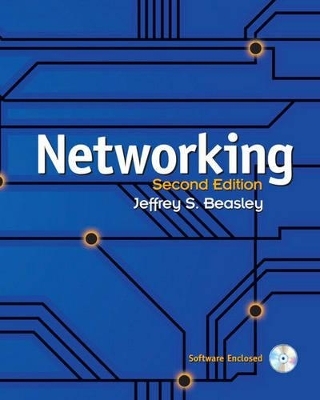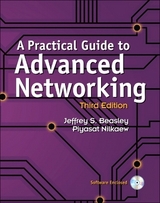
Networking
Prentice Hall Certification
978-0-13-135838-6 (ISBN)
- Titel erscheint in neuer Auflage
- Artikel merken
Second Edition
Jeffrey S. Beasley
This text provides a comprehensive look at computer networking from the point of view of the network administrator. It guides readers from an entry-level knowledge in computer networks to advanced concepts in Ethernet networks; router configuration; TCP/IP networks; local-, campus-, and wide-area network configuration; network security; optical networks; voice over IP; and industrial networks. Extensive examples on the Windows Server 2003/2008 configuration and system configuration for the Linux operating system are also included. A complete chapter is devoted to protecting and securing a network from potential network attacks. Topics include denial of service attacks, firewalls, intrusion detection, password cracking, packet sniffing, and analyzing unsecured data packets. Other key network security issues, such as configuring router access lists, configuring a virtual private network (VPN) connection, and securing wireless networks, are also covered. Router configuration is examined, ranging from an introduction to router configuration to configuring multiple routing protocols for intranet and Internet data traffic. Routing protocols key to basic network operations are examined, including static, RIP, IGRP, OSPF, EIGRP, and BGP. The discussions on routing protocols are accompanied with in-depth steps for configuring the router to run the protocol, verify operation, and troubleshoot the router.
Key Pedagogical Features
NET-CHALLENGE SOFTWARE provides a simulated, hands-on experience in configuring routers and switches. Exercises provided in the text and on the CD challenge readers to undertake certain router/switch network configuration tasks. The software has the look and feel of actually being connected to the router or switch console port.
PROTOCOL ANALYZER SOFTWARE included with the text uses the Finisar Surveyor Demo. Examples of using the software to analyze data traffic are included throughout the text.
ACCOMPANYING CD-ROM includes the Finisar Surveyor Demo software and captured data traffic used in the text, which enables readers to capture data traffic on their own networks.
CONFIGURING, ANALYZING, or TROUBLESHOOTING sections are included with each chapter to guide the reader through advanced techniques in networking.
OBJECTIVES and INTRODUCTION at the beginning of each chapter clearly outline specific goals for the reader.
EXTENSIVE PROBLEM SETS, SUMMARIES, and QUESTIONS AND PROBLEMS (including Critical Thinking questions) are found at the end of each chapter.
KEY TERMS and their definitions are highlighted in the margins to foster inquisitiveness and ensure retention.
Jeff Beasley is a professor with the Department of Engineering Technology at New Mexico State University. He has been teaching with the department since 1988 and is the co-author of Modern Electronic Communication and Electronic Devices and Circuits. http://web.nmsu.edu/~jbeasley/
Chapter 1 Introduction to Computer Networks
1-1 INTRODUCTION 5
1-2 NETWORK TOPOLOGIES 5
1-3 THE ETHERNET LAN
IP (Internet Protocol) Addressing
1-4 ASSEMBLING A HOME NETWORK
Securing the Home Network
IP Addressing in the Home Network
1-5 ASSEMBLING AN OFFICE LAN
1-6 TESTING AND TROUBLESHOOTING A LAN
1-7 ANALYZING COMPUTER NETWORKS
Summary
Questions and Problems
Chapter 2 Physical Layer Cabling: Twisted Pair
2-1 INTRODUCTION
2-2 STRUCTURED CABLING
Horizontal Cabling
2-3 UNSHIELDED TWISTED-PAIR CABLE
Shielded Twisted-pair Cable
2-4 TERMINATING CAT6/5E/5 UTP CABLES
Computer Communication
Straight-through and Crossover Patch Cables
2-5 CABLE TESTING AND CERTIFICATION
Testing the CAT6 Link
2-6 10 Gigabit Ethernet over Copper
Overview
Alien Crosstalk (AXT)
Signal Transmission
2-7 TROUBLESHOOTING COMPUTER NETWORKS
Installation
Cable Stretching
Cable Failing to Meet Manufacturer Specifications
CAT5e Cable Test Examples
Summary
Questions and Problems
Chapter 3 Computer Fundamentals
3-1 INTRODUCTION
3-2 THE COMPUTER BUS CONNECTION
Motherboard Bus Connections
3-3 DEVICE DRIVERS
Verifying Device Drivers on Windows Vista/XP
Verifying Device Drivers on Mac OS X
3-4 COMPUTER MEMORY
Types of Memory
3-5 AN OVERVIEW OF FAT AND NTFS
FAT
FAT32
NTFS
3-6 CONFIGURING THE BIOS BOOT SEQUENCE
Summary
Questions and Problems
Chapter 4 Interconnecting the LANs
4-1 INTRODUCTION
4-2 THE OSI MODEL
4-3 THE NETWORK BRIDGE
4-4 THE NETWORK SWITCH
Hub–Switch Comparison
Managed Switches
Multilayer Switches
4-5 THE ROUTER
The Router Interface: Cisco 2800 Series
The Router Interface—Cisco 2600 Series
The Router Interface—Cisco 2500 Series
4-6 INTERCONNECTING LANS WITH THE ROUTER
Gateway Address
Network Segments
4-7 CONFIGURING THE NETWORK INTERFACE—AUTONEGOTIATION
Auto-Negotiation Steps
Full Duplex/Half Duplex
Summary
Questions and Problems
Chapter 5 TCP/IP
5-1 INTRODUCTION
5-2 THE TCP/IP LAYERS
The Application Layer
The Transport Layer
The Internet Layer
The Network Interface Layer
5-3 NUMBER CONVERSION
Binary-Decimal Conversion
Decimal-Binary Conversion
Hexadecimal Numbers
5-4 IPV4 ADDRESSING
Private IP Addresses
IP Address Assignment
5-5 SUBNET MASKS
5-6 CIDR BLOCKS
5-7 IPV6 ADDRESSING
5-8 ANALYZING COMPUTER NETWORKS—FTP DATA PACKETS
Summary
Questions and Problems
Chapter 6 Introduction to Router Configuration
6-1 INTRODUCTION
6-2 ROUTER FUNDAMENTALS
Layer 3 Networks
6-3 THE CONSOLE PORT CONNECTION
Configuring the HyperTerminal Software (Windows)
Configuring the Z-Term Serial Communications Software (Mac)
6-4 THE ROUTER'S USER EXEC MODE (ROUTER>)
The User EXEC Mode
Router Configuration Challenge—The User EXEC Mode
6-5 THE ROUTER'S PRIVILEGED EXEC MODE (ROUTER#)
Hostname
Enable Secret
Setting the Line Console Passwords
Fast Ethernet Interface Configuration
Serial Interface Configuration
Router Configuration Challenge—The Privileged EXEC Mode
6-6 TROUBLESHOOTING THE ROUTER INTERFACE
Summary
Questions and Problems
Chapter 7 Routing Protocols
7-1 INTRODUCTION
7-2 STATIC ROUTING
Gateway of Last Resort
Configuring Static Routes
Networking Challenge—Static Routes
7-3 DYNAMIC ROUTING PROTOCOLS
Distance Vector Protocols
Link State Protocols
7-4 RIP—ROUTING INFORMATION PROTOCOL
Configuring Routes with RIP
Networking Challenge—RIP
7-5 IGRP—INTERIOR GATEWAY ROUTING PROTOCOL
Configuring Routes with IGRP
Networking Challenge—IGRP
7-6 OSPF—OPEN SHORTEST PATH FIRST ROUTING PROTOCOL
Configuring Routes with OSPF
Networking Challenge—OSPF
7-7 EIGRP—ENHANCED INTERIOR GATEWAY ROUTING PROTOCOL
Configuring Routes with EIGRP
Networking Challenge—EIGRP
7-8 CONFIGURING A JUNIPER ROUTER
Operational Mode
Router Configuration Mode
Displaying the Router Interfaces
Hostname Configuration
Assigning an IP Address to an Interface
Static Route
RIP Configuration
OSPF Configuration
7-9 TFTP—Trivial File Transfer Protocol
Configuring TFTP
Networking Challenge—TFTP
7-10 ANALYZING OSPF "HELLO" PACKETS
Summary
Questions and Problems
Chapter 8 Wide Area Networking
8-1 INTRODUCTION
8-2 THE LINE CONNECTION
Data Channels
Point of Presence
T1 Framing
Line Coding Formats
8-3 FRAME RELAY
Establishing a Frame Relay Connection
Configuring Frame Relay Point-to-Point on the Router
Networking Challenge—Frame Relay
8-4 ATM
Establishing the ATM Connection
8-5 DIAL-IN ACCESS
Analog Modem Technologies
Cable Modems
ISDN
xDSL Modems
The Remote Access Server
8-6 VPN
Configuring a VPN Virtual Interface (Router to Router)
Troubleshooting the VPN Tunnel Link
Configuring a VPN Server
Configuring a Remote Client's VPN Connection
8-7 WIDE AREA NETWORK ROUTING
8-8 INTERNET ROUTING
Configuring BGP
Networking Challenge—BGP
8-9 ANALYZING INTERNET DATA TRAFFIC
Utilization/Errors Strip Chart
Network Layer Matrix
Network Layer Host Table
Frame Size Distribution
Summary
Questions and Problems
Chapter 9 Configuring and Managing the Campus Network
9-1 INTRODUCTION
9-2 DESIGNING THE CAMPUS NETWORK
Core Layer
Distribution Layer
Access Layer
Data Flow
Selecting the Media
Load Balancing
9-3 IP ASSIGNMENT AND DHCP
The DHCP Data Packets
9-4 NETWORK SERVICES—DNS
Campus DNS
9-5 NETWORK MANAGEMENT
Configuring SNMP
Power over Ethernet (PoE)
9-6 Switch/VLAN Configuration
Virtual LAN (VLAN)
Switch Configuration
Hostname
Enable Secret
Setting the Line Console Passwords
Static VLAN Configuration
Networking Challenge—Static VLAN Configuration
Spanning-Tree Protocol
9-7 ANALYZING CAMPUS NETWORK DATA TRAFFIC
Summary
Questions and Problems
Chapter 10 Network Security
10-1 INTRODUCTION
10-2 INTRUSION (HOW AN ATTACKER GAINS CONTROL OF A NETWORK)
Social Engineering
Password Cracking
Packet Sniffing
Vulnerable Software
Viruses and Worms
Wireless Vulnerabilities
10-3 DENIAL OF SERVICE
Distributed Denial of Service Attacks (DDoS)
10-4 FIREWALLS AND ACCESS LISTS
Attack Prevention
10-5 INTRUSION DETECTION
10-6 ANALYZING UNSECURED DATA PACKETS
Summary
Questions and Problems
Chapter 11 Wireless Networking
11-1 INTRODUCTION
11-2 THE IEEE 802.11 WIRELESS LAN STANDARD
11-3 802.11 WIRELESS NETWORKING
11-4 Bluetooth, WiMAX, and RFID
Bluetooth
WiMAX
RFID (Radio Frequency Identification)
11-5 SECURING WIRELESS LANS
11-6 CONFIGURING A POINT-TO-MULTIPOINT WIRELESS LAN: A CASE STUDY
1. Antenna Site Survey
2. Establishing a Point-to-Point Wireless Link to the Home Network
3–4. Configuring the Multipoint Distribution/Conducting an RF Site Survey
5. Configuring the Remote Installations
Summary
Questions and Problems
Chapter 12 Optical Networking
12-1 INTRODUCTION
12-2 THE NATURE OF LIGHT
Graded-Index Fiber
Single-Mode Fibers
12-3 FIBER ATTENUATION AND DISPERSION
Attenuation
Dispersion
Dispersion Compensation
12-4 OPTICAL COMPONENTS
Intermediate Components
Detectors
Fiber Connectorization
12-5 OPTICAL NETWORKING ARCHITECTURES
Defining Optical Networking
Building Distribution
Campus Distribution
12-6 SYSTEM DESIGN AND OPERATIONAL ISSUES
12-7 SAFETY
12-8 TROUBLESHOOTING COMPUTER NETWORKS (THE OTDR)
Summary
Questions and Problems
Chapter 13 Voice over IP
13-1 INTRODUCTION
13-2 THE BASICS OF VOICE OVER IP
13-3 VOICE OVER IP NETWORKS
Replacing an Existing PBX Tie Line
Upgrading Existing PBXs to Support IP Telephony
Switching to a Complete IP Telephony Solution
13-4 QUALITY OF SERVICE
Jitter
Network Latency
Queuing
13-5 ANALYZING VoIP DATA PACKETS
Analyzing VoIP Telephone Call Data Packets
Summary
Questions and Problems
Chapter 14 The Network Server
14-1 INTRODUCTION
Network Definitions
Network Types
Server Types
Adding the Network Server
14-2 INSTALLING AND CONFIGURING THE NETWORK SERVER
Creating a Server Domain (Windows 2003 Server)
Configuring Windows 2008 Server
Configuring the IP Address
14-3 ADDING COMPUTERS, USERS, AND GROUPS
Adding Computers to the Windows 2008/2003 Server Domain
Adding Users to the Windows 2008/2003 Server Domain
Adding Organizational Units and Groups to the Windows 2008/2003 Server Domain
14-4 SETTING GROUP PERMISSIONS AND POLICIES
2008 Server: Setting Domain Policies
2003 Server: Setting Domain Policies
14-5 VERIFYING "NETWORK" AND "MY NETWORK PLACES" IN WINDOWS-BASED PCS
"Network," Windows Vista
"My Network Places" on Windows XP
"My Network Places" on Windows 2000
"Network Neighborhood" for Windows NT and 98
14-6 CONFIGURING THE NETWORK SERVER'S ACCOUNT LOCKOUT POLICY
Summary
Questions and Problems
Chapter 15 Linux Networking
15-1 INTRODUCTION
15-2 LOGGING ON TO LINUX
Adding a User Account
15-3 LINUX FILE STRUCTURE AND FILE COMMANDS
Listing Files
Displaying File Contents
Directory Operations
File Operations
Permissions and Ownership
15-4 LINUX ADMINISTRATION COMMANDS
The man (manual) Command
The ps (processes) Command
The su (substitute user) Command
The mountCommand
The shutdown Command
Linux Tips
15-5 ADDING APPLICATIONS TO LINUX
15-6 LINUX NETWORKING
Installing SSH
The ftp Client
The ftp Server
DNS Service on Linux
Changing the Hostname
15-7 TROUBLESHOOTING SYSTEM AND NETWORK PROBLEMS WITH LINUX
Troubleshooting Boot Processes
Listing Users on the System
Network Security
Enabling and Disabling Boot Services
15-8 MANAGING THE LINUX SYSTEM
Summary
Questions and Problems
Chapter 16 Industrial Networks
16-1 INTRODUCTION
16-2 OVERVIEW OF INDUSTRIAL NETWORKS
Characteristics of Industrial Networks
16-3 INDUSTRIAL ETHERNET
Achieving Determinism
Topology
Switching
Cabling and Components
16-4 INDUSTRIAL ETHERNET PROTOCOLS
Ethernet/IP
Foundation Fieldbus High-Speed Ethernet (HSE)
Profinet
Interface for Distributed Automation (IDA)
Manufacturing Message Specification (MMS)
Modbus TCP
16-5 LEGACY DEVICE AND CONTROLLER LEVEL BUSES
Open Buses
Proprietary Buses
Summary
Questions and Problems
Glossary
0131358383 TOC 8/4/2008
| Erscheint lt. Verlag | 11.9.2008 |
|---|---|
| Reihe/Serie | Certification |
| Verlagsort | Upper Saddle River |
| Sprache | englisch |
| Maße | 259 x 208 mm |
| Gewicht | 1594 g |
| Themenwelt | Mathematik / Informatik ► Informatik ► Netzwerke |
| ISBN-10 | 0-13-135838-3 / 0131358383 |
| ISBN-13 | 978-0-13-135838-6 / 9780131358386 |
| Zustand | Neuware |
| Haben Sie eine Frage zum Produkt? |
